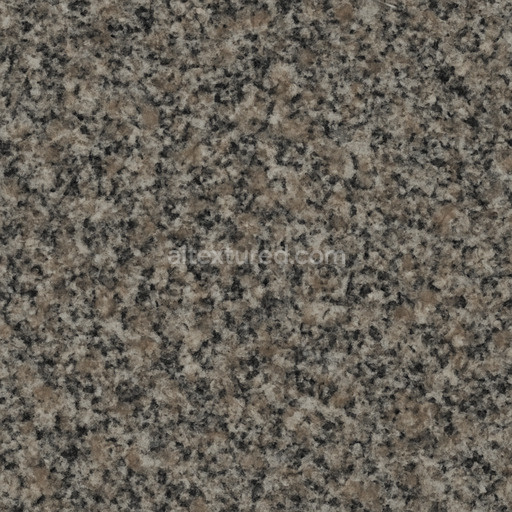The granite medium speckle polished texture is a meticulously crafted high-resolution surface designed to authentically replicate the natural composition and refined finish of medium-grain granite stone. This seamless granite medium speckle polished texture captures the intricate mineral interplay of feldspar, quartz, and mica aggregates, naturally fused within a dense silicate matrix. The stone’s polished surface is characterized by smooth, reflective qualities combined with subtle color variations ranging from soft grays to warm beige speckles, accurately representing mineral pigments and oxide layers typical of authentic granite. The texture’s low porosity and inherent weathering resistance are conveyed through carefully balanced roughness and ambient occlusion maps, reflecting the durable, solid nature of this classic natural stone ideal for both indoor and outdoor architectural applications.
Engineered for modern 3D workflows, this tileable granite medium speckle polished AI texture includes all essential physically based rendering (PBR) channels: BaseColor (Albedo), Normal, Roughness, Metallic, Ambient Occlusion, and Height/Displacement. The BaseColor map reveals the natural speckled coloration and subtle mineral tonal shifts, while the Normal and Height maps simulate the polished stone’s gentle surface relief and micro-variations, adding depth without harsh irregularities. The Roughness map highlights the glossy, smooth finish characteristic of polished granite, enabling realistic reflections under varied lighting. The Metallic channel remains minimal, accurately portraying the non-metallic stone nature, while Ambient Occlusion enhances shadowing in grain boundaries and crevices, improving depth perception in close-up and large-scale 3D preview environments. With resolution options up to 8K, this seamless granite medium speckle polished texture delivers exceptional detail and visual fidelity compatible with Blender, Unreal Engine, and Unity projects.
This granite medium speckle polished texture offers a versatile, high-quality solution for architectural surfaces, environment art, and concept visualization requiring authentic stone textures. For optimal results, adjusting the UV scale to match your object’s proportions and viewing distance is recommended to preserve fine medium speckle detail and avoid repetition artifacts. Additionally, fine-tuning roughness and normal map intensity within your shader setup enhances the polished granite’s subtle reflections and tactile depth, adapting naturally to varying light conditions. Incorporating the height or displacement maps for parallax or tessellation effects further elevates surface realism, especially in close-up scenes where material detail is critical. Overall, this seamless granite medium speckle polished texture combines meticulous craftsmanship with high-resolution clarity to enrich your 3D preview environments with believable, durable stone surfaces.
How to Use These Seamless PBR Textures in Blender
This guide shows how to connect a full PBR texture set to Principled BSDF in Blender (Cycles or Eevee). Works with any of our seamless textures free download, including PBR PNG materials for Blender / Unreal / Unity.
What’s inside the download
*_albedo.png — Base Color (sRGB)*_normal.png — Normal map (Non-Color)*_roughness.png — Roughness (Non-Color)*_metallic.png — Metallic (Non-Color)*_ao.png — Ambient Occlusion (Non-Color)*_height.png — Height / Displacement (Non-Color)*_ORM.png — Packed map (R=AO, G=Roughness, B=Metallic, Non-Color)

Quick start (Node Wrangler, 30 seconds)
- Enable the addon: Edit → Preferences → Add-ons → Node Wrangler.
- Create a material and select the Principled BSDF node.
- Press Ctrl + Shift + T and select the maps
albedo, normal, roughness, metallic (skip height and ORM for now) → Open.
The addon wires Base Color, Normal (with a Normal Map node), Roughness, and Metallic automatically.
- Add AO and Height using the “Manual wiring” steps below (5 and 6).
Manual wiring (full control)
- Create a material (Material Properties → New) and open the Shader Editor.
- Add an Image Texture node for each map. Set Color Space:
- Albedo → sRGB
- AO, Roughness, Metallic, Normal, Height, ORM → Non-Color
- Connect to Principled BSDF:
albedo → Base Colorroughness → Roughnessmetallic → Metallic (for wood this often stays near 0)normal → Normal Map node (Type: Tangent Space) → Normal of Principled.
If details look “inverted”, enable Invert Y on the Normal Map node.
- Ambient Occlusion (AO):
- Add a MixRGB (or Mix Color) node in mode Multiply.
- Input A =
albedo, Input B = ao, Factor = 1.0.
- Output of Mix → Base Color of Principled (replaces the direct albedo connection).
- Height / Displacement:
Cycles — true displacement
- Material Properties → Settings → Displacement: Displacement and Bump.
- Add a Displacement node: connect
height → Height, set Midlevel = 0.5, Scale = 0.02–0.08 (tune to taste).
- Output of Displacement → Material Output → Displacement.
- Add geometry density (e.g., Subdivision Surface) so displacement has polygons to work with.
Eevee (or lightweight Cycles) — bump only
- Add a Bump node:
height → Height.
- Set Strength = 0.2–0.5, Distance = 0.05–0.1, and connect Normal output to Principled’s Normal.
Using the packed ORM texture (optional)
Instead of separate AO/Roughness/Metallic maps you can use the single *_ORM.png:
- Add one Image Texture (Non-Color) → Separate RGB (or Separate Color).
- R (red) → AO (use it in the Multiply node with albedo as above).
- G (green) → Roughness of Principled.
- B (blue) → Metallic of Principled.
UVs & seamless tiling
- These textures are seamless. If your mesh has no UVs, go to UV Editing → Smart UV Project.
- For scale/repeat, add Texture Coordinate (UV) → Mapping and plug it into all texture nodes.
Increase Mapping → Scale (e.g., 2/2/2) to tile more densely.
Recommended starter values
- Normal Map Strength: 0.5–1.0
- Bump Strength: ~0.3
- Displacement Scale (Cycles): ~0.03
Common pitfalls
- Wrong Color Space (normals/roughness/etc. must be Non-Color).
- “Inverted” details → enable Invert Y on the Normal Map node.
- Over-strong relief → lower Displacement Scale or Bump Strength.
Example: Download Wood Textures and instantly apply parquet or rustic planks inside Blender for architectural visualization.
To add the downloaded texture, go to Add — Texture — Image Texture.

Add a node and click the Open button.

Select the required texture on your hard drive and connect Color to Base Color.


